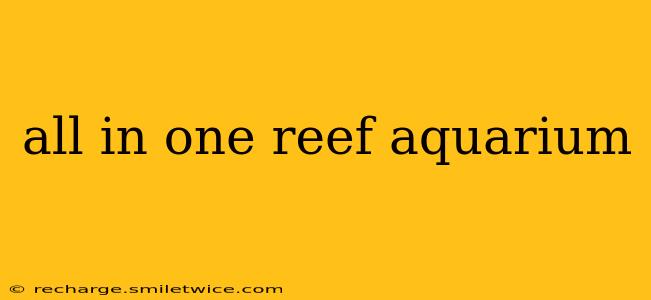The allure of a thriving reef aquarium, teeming with vibrant corals and fascinating fish, is undeniable. However, the complexity of maintaining a successful reef tank can be daunting. All-in-one (AIO) reef aquariums offer a streamlined solution, combining the essential components into a single, compact unit. This comprehensive guide explores the benefits, considerations, and maintenance required for these increasingly popular systems.
What is an All-in-One Reef Aquarium?
An AIO reef aquarium integrates the sump, protein skimmer, and sometimes even a return pump, into the main tank itself. This design simplifies setup, reduces footprint, and often lowers the initial cost compared to larger, multi-component reef systems. They are perfect for beginners due to their ease of use and maintenance, but advanced hobbyists also appreciate their sleek design and space-saving features. The components are usually built into the back or bottom of the tank, maintaining a clean aesthetic.
Are AIO Reef Tanks Good for Beginners?
Yes, AIO reef tanks are generally considered excellent for beginners. Their compact design and integrated systems minimize the complexity of setup and maintenance. The smaller water volume also makes it easier to manage water parameters and react to any issues more quickly. However, success still requires research, diligent maintenance, and a commitment to learning about reef aquarium husbandry.
What are the Advantages of an AIO Reef Tank?
- Simplified Setup: The integrated system significantly simplifies the initial setup process compared to traditional reef tanks. Less plumbing and equipment mean less to assemble and potentially troubleshoot.
- Space-Saving Design: AIO tanks are ideal for smaller spaces, maximizing the beauty of a reef environment without taking up excessive room.
- Cost-Effective: Often, AIO units have a lower initial purchase price than comparable traditional reef systems.
- Easy Maintenance: Integrated components make routine maintenance tasks, such as water changes, simpler and more efficient.
- Aesthetically Pleasing: The sleek and compact design enhances the visual appeal of the aquarium, allowing the vibrant corals and fish to take center stage.
What are the Disadvantages of an AIO Reef Tank?
- Limited Customization: Upgrading or modifying components within an AIO system can be more challenging than in a traditional setup.
- Smaller Water Volume: The smaller water volume can make it more susceptible to fluctuations in water parameters, requiring more vigilant monitoring.
- Potential for Overcrowding: The restricted space necessitates careful consideration of stocking levels to prevent overpopulation.
- Reduced Upgradability: The integrated design may limit the options for future upgrades to more powerful filtration or other equipment.
How Much Does an AIO Reef Tank Cost?
The cost of an AIO reef tank varies greatly depending on the size, features, and brand. Smaller, entry-level systems can start around $300, while larger, more advanced models can cost several thousand dollars. It's crucial to factor in the cost of additional equipment like lighting, filtration media, and test kits.
What Size AIO Reef Tank Should I Get?
The ideal size of your AIO reef tank depends on your experience level, available space, and desired stocking levels. Beginners often start with smaller tanks (10-20 gallons) to gain experience, while experienced hobbyists may opt for larger systems (30 gallons or more). Remember that larger tanks offer greater stability in water parameters, but also require more significant maintenance.
How Do I Maintain an AIO Reef Aquarium?
Maintaining an AIO reef aquarium involves regular water changes, monitoring water parameters (temperature, salinity, ammonia, nitrite, nitrate, pH), cleaning the filter media, and careful observation of your corals and fish. Regular testing and prompt action to address any issues are crucial to maintaining a healthy reef environment.
What are the best AIO Reef Tanks?
The "best" AIO reef tank depends on individual needs and preferences. Researching different brands and models, reading reviews, and considering your budget and experience level will guide you to the most suitable option. Factors to consider include tank size, included features (lighting, filtration, etc.), and overall build quality.
This comprehensive guide offers a solid foundation for understanding AIO reef aquariums. Remember, thorough research and a commitment to learning are essential for success in this rewarding hobby. With careful planning and diligent maintenance, you can create a stunning and thriving reef ecosystem in your own home.
